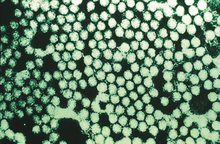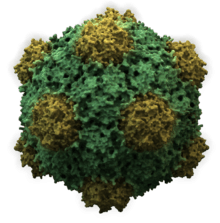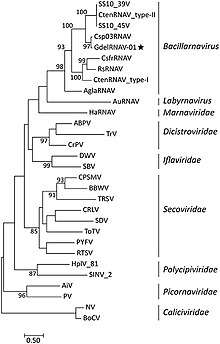Picornavirales
Picornavirales is an order of viruses with vertebrate, insect, algal or plant hosts.[1] The name has a dual etymology.[2] First, picorna- is an acronym for poliovirus, insensitivity to ether, coxsackievirus, orphan virus, rhinovirus, and ribonucleic acid.[2] Secondly, pico-, meaning extremely small, combines with RNA to describe these very small RNA viruses.[2]
| Picornavirales | |
|---|---|
 | |
| Electronmicrograph of Foot-and-mouth disease virus | |
 | |
| Structure of the Cowpea mosaic virus | |
| Virus classification | |
| (unranked): | Virus |
| Realm: | Riboviria |
| Kingdom: | Orthornavirae |
| Phylum: | Pisuviricota |
| Class: | Pisoniviricetes |
| Order: | Picornavirales |
Characteristics
The families within this order share a number of common features:
- The virions are non-enveloped, icosahedral, and about 30 nanometers in diameter.
- The capsid has a "pseudo T=3" structure, and is composed of 60 protomers each made of three similar-sized but nonidentical beta barrels.
- The genome is made of one or a few single-stranded RNA(s) serving directly as mRNA, without overlapping open reading frames.
- The genome has a small protein, VPg, covalently attached to its 5' end, and usually a poly-adenylated 3' end.
- Each genome RNA is translated into polyprotein(s) yielding mature viral proteins through one or several virus-encoded proteinase(s).
- A hallmark of the Picornavirales is a conserved module of sequence domains, Hel-Pro-Pol, which is typical of (from the amino- to the carboxy-end of the polyprotein):
- A helicase belonging to superfamily III
- [the VPg is encoded between these two domains]
- A chymotrypsin-like protease where the catalytic residue is typically a cysteine rather than a serine,
- A polymerase belonging to superfamily I; this conserved module is a hallmark of the Picornavirales
The evolution of picorna-like viruses seems to have antedated the separation of eukaryotes into the extant crown groups.[3]
Taxonomy

Phylogenetic tree of representative viruses from order Picornavirales
The following families are recognized:[4]
- Caliciviridae
- Dicistroviridae
- Iflaviridae
- Marnaviridae
- Picornaviridae
- Polycipiviridae
- Secoviridae
- Solinviviridae
gollark: Well, just removing Windows is 1, I guess.
gollark: Arch Linux: Remove Windows in probably just 20 or more commands!
gollark: All you need are some nanometre-precision scissors and a very steady hand.
gollark: It's hard to make things which are good at *both* of those, and you would deal with twice the heat in one place.
gollark: CPUs have to execute x86 (or ARM or other things, but generally a documented, known instruction set) very fast sequentially, GPUs can execute basically whatever they want as long as it can be generated from one of the standard ways to interface with them, and do it in a massively parallel way.
References
- Le Gall, Olivier; Christian, Peter; Fauquet, Claude M.; King, Andrew M. Q.; Knowles, Nick J.; Nakashima, Nobuhiko; Stanway, Glyn; Gorbalenya, Alexander E. (2008-04-01). "Picornavirales, a proposed order of positive-sense single-stranded RNA viruses with a pseudo-T = 3 virion architecture". Archives of Virology. 153 (4): 715–27. doi:10.1007/s00705-008-0041-x. PMID 18293057.
- "Picornaviridae". International Committee on Taxonomy of Viruses (ICTV). October 2017. Retrieved 5 February 2019.
- Koonin, Eugene V.; Wolf, Yuri I.; Nagasaki, Keizo; Dolja, Valerian V. (2008). "The Big Bang of picorna-like virus evolution antedates the radiation of eukaryotic supergroups". Nature Reviews Microbiology. 6 (12): 925–939. doi:10.1038/nrmicro2030. PMID 18997823.
- "Virus Taxonomy: 2019 Release". talk.ictvonline.org. International Committee on Taxonomy of Viruses. Retrieved 30 April 2020.
External links
This article is issued from Wikipedia. The text is licensed under Creative Commons - Attribution - Sharealike. Additional terms may apply for the media files.